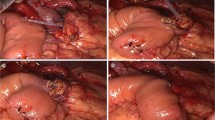Abstract
Purpose
Pancreatic anastomosis and stump closure after partial pancreatectomy is the most critical step in pancreas surgery due to a high percentage of postoperative fistulas. Whether transverse cut side branches or the main pancreatic duct presents the source of this leak is still unknown. Thus, better understanding of the anatomy of the pancreatic duct system in the resection area could significantly improve the surgical technique and reduce complications.
Methods
We investigated the anatomy of the pancreatic duct in 25 human cadaveric pancreata with focus on the corpus area. Contrast agent was instilled into the pancreatic duct, and computed tomography was used to visualize the duct system in detail.
Results
In addition to the main and accessory pancreatic duct in the head, an additional accessory duct was observed within the pancreas corpus in 16% of the cases. Within the plane of the portal vein, fewer transversely cut side branches were observed as compared to the resection planes 2–4 cm beneath. The number of side branches was independent of the presence of pancreatic fibrosis.
Conclusions
From anatomical point of view, the resection level at the porto-mesenteric axis appears to be ideal. However, the presence of an accessory main duct has to be taken into account for sufficient surgical supply.





Similar content being viewed by others
References
Berberat PO, Friess H, Kleeff J et al (1999) Prevention and treatment of complications in pancreatic cancer surgery. Dig Surg 16:327–336
Hopt HP, Makowiec F, Adam U (2005) Technik und Risiko von Pankreasanastomosen. Viszeralchirurgie 40:128–134
Knaebel HP, Diener MK, Wente MN et al (2005) Systematic review and meta-analysis of technique for closure of the pancreatic remnant after distal pancreatectomy. Br J Surg 92:539–546
Kleeff J, Diener MK, Z'Graggen K et al (2007) Distal pancreatectomy: risk factors for surgical failure in 302 consecutive cases. Ann Surg 245:573–582
Cattell RB (1948) A technic for pancreatoduodenal resection. Surg Clin North Am 28:761–775
Sobotta J (1914) Die Anatomie der Bauchspeicheldrüse. In: Sobotta J (ed) Handbuch der Anatomie VI, 3. Abt. I Darmsystem. Gustav Fischer Verlag, Jena, pp 1–66
Hentschel M (1968) Variationen der Pankreasgang-Anatomie und Duodenalstumpfverschluß. Der Chirurg 39:181–184
Ishii H, Arai K, Fukushima M et al (1998) Fusion variations of pancreatic ducts in patients with anomalous arrangement of pancreaticobiliary ductal system. J Hepatobiliary Pancreat Surg 5:327–332
Bang S, Suh JH, Park BK et al (2006) The relationship of anatomic variation of pancreatic ductal system and pancreaticobiliary diseases. Yonsei Med J 47:243–248
Trede M (1997) Embryology and surgical anatomy of the pancreas. In: Trede M, Carter DC, Trede M (eds) Surgery of the pancreas, 2nd edn. Elsevier, Oxford, pp 17–27
Kloppel G, Maillet B (1991) Pseudocysts in chronic pancreatitis: a morphological analysis of 57 resection specimens and 9 autopsy pancreata. Pancreas 6:266–274
Detlefsen S, Sipos B, Feyerabend B et al (2005) Pancreatic fibrosis associated with age and ductal papillary hyperplasia. Virchows Arch 447:800–805
Langrehr JM, Bahra M, Jacob D et al (2005) Prospective randomized comparison between a new mattress technique and Cattell (duct-to-mucosa) pancreaticojejunostomy for pancreatic resection. World J Surg 29:1111–1119 1120-1111
Bartoli FG, Arnone GB, Ravera G et al (1991) Pancreatic fistula and relative mortality in malignant disease after pancreaticoduodenectomy. Review and statistical meta-analysis regarding 15 years of literature. Anticancer Res 11:1831–1848
Hamanaka Y, Nishihara K, Hamasaki T et al (1996) Pancreatic juice output after pancreatoduodenectomy in relation to pancreatic consistency, duct size, and leakage. Surgery 119:281–287
Acknowledgment
We would like to thank Manuela Schneider and Horst Bergauer for excellent technical assistance.
Author information
Authors and Affiliations
Corresponding author
Rights and permissions
About this article
Cite this article
Steger, U., Range, P., Mayer, F. et al. Pancreatic duct anatomy in the corpus area: implications for closure and anastomotic technique in pancreas surgery. Langenbecks Arch Surg 395, 201–206 (2010). https://doi.org/10.1007/s00423-009-0526-4
Received:
Accepted:
Published:
Issue Date:
DOI: https://doi.org/10.1007/s00423-009-0526-4




